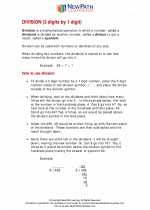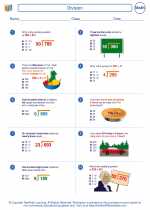Integers
Integers are whole numbers that can be positive, negative, or zero. They are represented on the number line as follows:
- Negative integers: ..., -3, -2, -1
- Zero: 0
- Positive integers: 1, 2, 3, ...
Operations with Integers
When performing operations with integers, there are a few rules to keep in mind:
- Addition: When adding integers with the same sign, add their absolute values and keep the sign. When adding integers with different signs, subtract the number with the smaller absolute value from the one with the larger absolute value and keep the sign of the number with the larger absolute value.
- Subtraction: To subtract an integer, add its opposite.
- Multiplication: When multiplying integers, if the signs are the same, the product is positive. If the signs are different, the product is negative.
- Division: When dividing integers, if the signs are the same, the quotient is positive. If the signs are different, the quotient is negative.
Absolute Value
The absolute value of an integer is its distance from zero on the number line. It is always a positive number.
Study Guide
Here are some key points to remember when studying integers:
- Know the definition of integers and be able to identify positive, negative, and zero integers.
- Understand the rules for addition, subtraction, multiplication, and division of integers.
- Practice finding the absolute value of integers and understand its significance in relation to the number line.
- Complete practice problems to reinforce your understanding of integers and their operations.
By mastering the concepts and rules related to integers, you will be well-prepared for more advanced topics in mathematics.
.◂Math Worksheets and Study Guides Sixth Grade. Division
Study Guide Division
Division  Worksheet/Answer key
Worksheet/Answer key Division
Division  Worksheet/Answer key
Worksheet/Answer key Division
Division  Worksheet/Answer key
Worksheet/Answer key Division
Division 

 Worksheet/Answer key
Worksheet/Answer key
 Worksheet/Answer key
Worksheet/Answer key
 Worksheet/Answer key
Worksheet/Answer key

The resources above cover the following skills:
Connections to the Grade 6 Focal Points (NCTM)
Number and Operations: Students' work in dividing fractions shows them that they can express the result of dividing two whole numbers as a fraction (viewed as parts of a whole). Students then extend their work in grade 5 with division of whole numbers to give mixed number and decimal solutions to division problems with whole numbers. They recognize that ratio tables not only derive from rows in the multiplication table but also connect with equivalent fractions. Students distinguish multiplicative comparisons from additive comparisons.